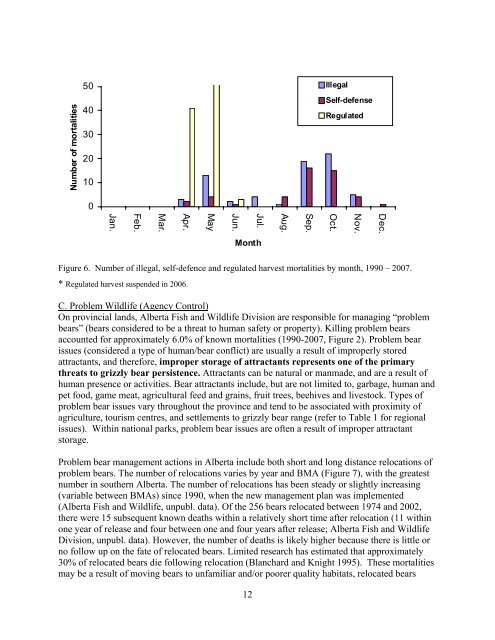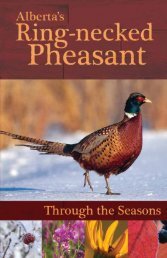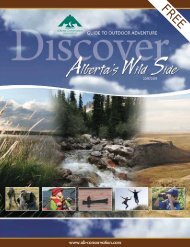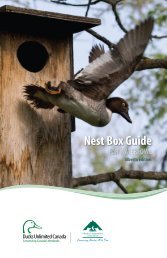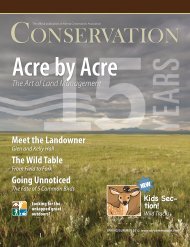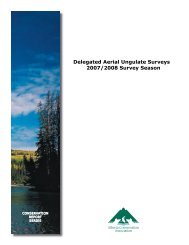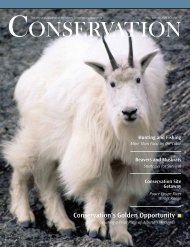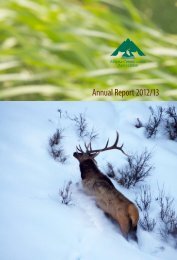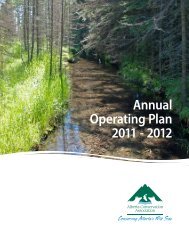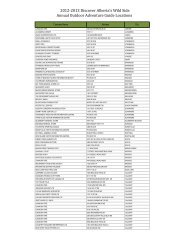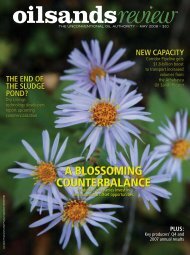Alberta Grizzly Bear Recovery Plan 2008-2013 - Alberta Sustainable ...
Alberta Grizzly Bear Recovery Plan 2008-2013 - Alberta Sustainable ...
Alberta Grizzly Bear Recovery Plan 2008-2013 - Alberta Sustainable ...
Create successful ePaper yourself
Turn your PDF publications into a flip-book with our unique Google optimized e-Paper software.
Number of mortalities<br />
50<br />
40<br />
30<br />
20<br />
10<br />
Illegal<br />
Self-defense<br />
Regulated<br />
0<br />
Dec.<br />
Nov.<br />
Oct.<br />
Sep.<br />
Aug.<br />
Jul.<br />
Jun.<br />
May<br />
Apr.<br />
Mar.<br />
Feb.<br />
Jan.<br />
Month<br />
Figure 6. Number of illegal, self-defence and regulated harvest mortalities by month, 1990 – 2007.<br />
* Regulated harvest suspended in 2006.<br />
C. Problem Wildlife (Agency Control)<br />
On provincial lands, <strong>Alberta</strong> Fish and Wildlife Division are responsible for managing “problem<br />
bears” (bears considered to be a threat to human safety or property). Killing problem bears<br />
accounted for approximately 6.0% of known mortalities (1990-2007, Figure 2). Problem bear<br />
issues (considered a type of human/bear conflict) are usually a result of improperly stored<br />
attractants, and therefore, improper storage of attractants represents one of the primary<br />
threats to grizzly bear persistence. Attractants can be natural or manmade, and are a result of<br />
human presence or activities. <strong>Bear</strong> attractants include, but are not limited to, garbage, human and<br />
pet food, game meat, agricultural feed and grains, fruit trees, beehives and livestock. Types of<br />
problem bear issues vary throughout the province and tend to be associated with proximity of<br />
agriculture, tourism centres, and settlements to grizzly bear range (refer to Table 1 for regional<br />
issues). Within national parks, problem bear issues are often a result of improper attractant<br />
storage.<br />
Problem bear management actions in <strong>Alberta</strong> include both short and long distance relocations of<br />
problem bears. The number of relocations varies by year and BMA (Figure 7), with the greatest<br />
number in southern <strong>Alberta</strong>. The number of relocations has been steady or slightly increasing<br />
(variable between BMAs) since 1990, when the new management plan was implemented<br />
(<strong>Alberta</strong> Fish and Wildlife, unpubl. data). Of the 256 bears relocated between 1974 and 2002,<br />
there were 15 subsequent known deaths within a relatively short time after relocation (11 within<br />
one year of release and four between one and four years after release; <strong>Alberta</strong> Fish and Wildlife<br />
Division, unpubl. data). However, the number of deaths is likely higher because there is little or<br />
no follow up on the fate of relocated bears. Limited research has estimated that approximately<br />
30% of relocated bears die following relocation (Blanchard and Knight 1995). These mortalities<br />
may be a result of moving bears to unfamiliar and/or poorer quality habitats, relocated bears<br />
12


